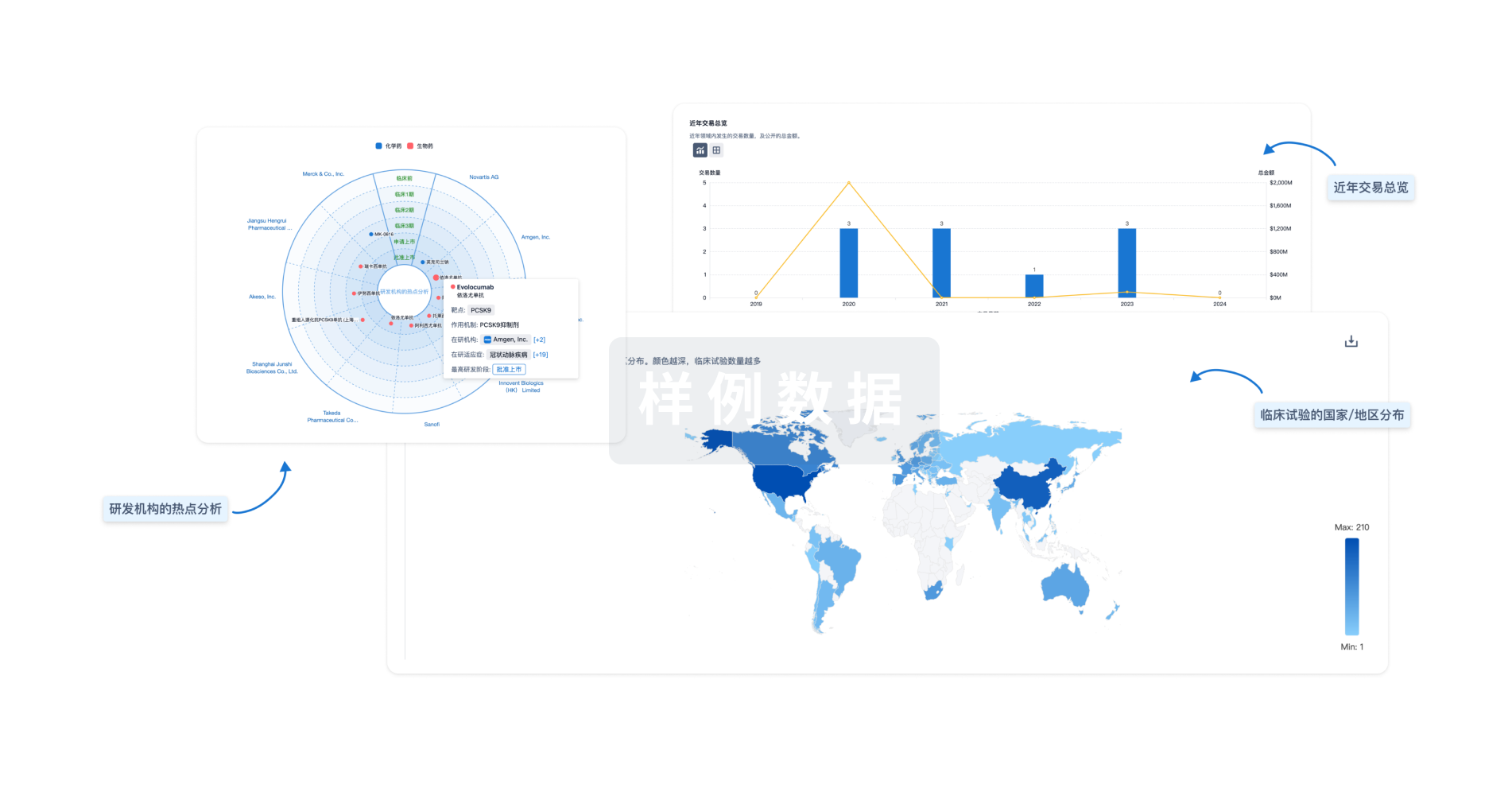预约演示
更新于:2025-05-07
HOXB8
更新于:2025-05-07
基本信息
别名 homeobox B8、Homeobox protein Hox-2.4、Homeobox protein Hox-2D + [4] |
简介 Sequence-specific transcription factor which is part of a developmental regulatory system that provides cells with specific positional identities on the anterior-posterior axis. |
关联
100 项与 HOXB8 相关的临床结果
登录后查看更多信息
100 项与 HOXB8 相关的转化医学
登录后查看更多信息
0 项与 HOXB8 相关的专利(医药)
登录后查看更多信息
220
项与 HOXB8 相关的文献(医药)2025-03-06·Brain
A role for leucine-rich, glioma inactivated 1 in regulating pain sensitivity
Article
作者: Patel, Ryan ; Chan, Marva ; Su, Yuhe ; Bannister, Kirsty ; Dawes, John M ; Feroz, Faisal ; Barry, Allison M ; Poplawski, Piotr ; Price, Theodore J ; Paul, Ivan ; Farah, Adham ; Dubb, Akash ; Daifallah, Omar ; Tseng, Mandy ; Cheng, Hoi lao ; Bennett, David L ; Wastie, Benjamin J ; Zeilhofer, Hanns Ulrich
2025-01-15·Bioconjugate Chemistry
Toolbox of Clickable Benzylguanines for Labeling of HoxB8-Derived Macrophages via SNAP-Tag and Bioorthogonal Chemistry
Article
作者: Hüwel, Sabine ; Schöning, Jonas ; Depke, Dominic Alexej ; Rentmeister, Andrea ; Schäfers, Michael ; Kukhar, Anastasiia ; Rösner, Lukas
2025-01-01·Allergy
Clinical utility analysis of the Hoxb8 mast cell activation test for the diagnosis of peanut allergy
Article
作者: Celik, Alper ; Duan, Lucy ; Eiwegger, Thomas ; Roos, Nadine ; van Brummelen, Robin ; Steinmann, Melanie ; Bachmeier‐Zbären, Noemi ; Ditlof, Christina M. ; Hoang, Jennifer A. ; Kaufmann, Thomas ; Yin, Xiaojun ; Upton, Julia E. M. ; Eggel, Alexander
1
项与 HOXB8 相关的新闻(医药)2024-09-01
·生物探索
引言
三阴性乳腺癌(TNBC)是一种高度异质性的疾病,展现出极高的侵袭性【1】,常规的内分泌治疗或化疗对此类癌症通常无效【2】。之前的基因组、转录组和蛋白质组分析发现TNBC缺乏有效的生物标志物来指导治疗决策和预测治疗反应【3】,因此从新的角度深入理解TNBC病理生物学特性尤为重要。
三维染色质结构指的是染色质在细胞核中的空间排列,包括染色质区域如何折叠、聚集以及它们如何与核小体和其他核内结构相互作用。在肿瘤中,染色质结构的异常重组可能导致染色质可及性变化,进而使原本静默的致癌基因被激活,或者抑癌基因被抑制。染色质结构的改变也可以影响染色体上的表观遗传标记,进而影响基因表达。尽管三维染色质结构对肿瘤表型的影响非常关键,但TNBC染色质结构的调控机制仍知之甚少。
2024年8月28日,广东省人民医院、中山大学、广州市妇女儿童中心、桂林医科大学附属医院及顺德医院的联合科研团队,以赵蔚和李杰两位 教授为通讯作者,在Nature Cancer上发表了题为Phase separation of phospho-HDAC6 drives aberrant chromatin architecture in triple-negative breast cancer的论文。该研究发现磷酸化形式的HDAC6蛋白在TNBC细胞的核内转录活跃区域形成了液液相分离(LLPS)凝聚体,而在非TNBC中这种现象较少见。研究还鉴定出Nexturastat A作为磷酸化HDAC6 LLPS抑制剂,显示出能够导致染色质结构重塑和转录谱改变,有效抑制TNBC的肿瘤生长。该论文首次揭示了TNBC中存在磷酸化形式的HDAC6蛋白,并且干预磷酸化HDAC6的相分离可能为开发TNBC的治疗的新策略。
该研究显示与非TNBC及相邻非癌组织相比,TNBC中HDAC6在细胞核表达显著增加,且主要以磷酸化形式存在。通过对HDAC6的潜在磷酸化位点进行突变分析,发现特定位点Ser22的磷酸化对其核内定位至关重要,这种磷酸化状态与肿瘤的分期及转移显著相关,并与患者的总生存期负相关。超分辨率显微镜观察发现,TNBC细胞中磷酸化HDAC6倾向于在细胞核中形成LLPS的凝聚体,这些凝聚体主要分布在活跃的染色质区域,并与转录活跃相关的标记物共定位。此外,实验还观察到表皮生长因子(EGF)能通过特定的激酶GRK2显著增加磷酸化HDAC6的水平和凝聚体形成。
接下来,研究团队探讨了HDAC6的两个主要固有无序区域(IDRs)在相分离作用。研究发现,HDAC6的第一个无序区域(IDR1)的删除显著减少了磷酸化HDAC6的相分离,而第二个无序区域(IDR2)的删除则对相分离没有显著影响。此外,IDR1内Ser22位点的磷酸化状态对其相分离能力有重要影响。进一步的实验表明,HDAC6的特定结构域,如核输出信号(NES)域的删除,显著增强了HDAC6在核内的定位和相分离能力。
探究肿瘤中异常LLPS凝聚体形成的机制不仅有助于理解染色质结构在基因表达调控中的角色,而且可能为开发新的治疗策略提供线索。例如,NUP98-HOXA9的LLPS有助于形成广泛的超级增强子(SE)样结合模式,从而促进白血病基因的转录激活4。此外,赵蔚团队之前的研究发现,HOXB8和FOSL1在染色质的SE位点形成的LLPS导致了骨肉瘤中转录的失调5。尽管LLPS在癌症中具有重要作用,但如何特异性破坏癌症中LLPS凝聚体仍有待探索。
研究团队通过基于相分离蛋白的筛选,发现了一种名为Nexturastat A的HDAC6抑制剂,该抑制剂能有效地抑制TNBC中磷酸化HDAC6凝聚体的形成。相比之下,另一种HDAC6抑制剂HPOB则未能达到相同的效果。实验表明,Nexturastat A通过降低磷酸化HDAC6的LLPS,从而抑制TNBC细胞的增殖、瘤球形成能力和侵袭性,同时促进细胞凋亡。Nexturastat A在体内显著抑制了TNBC的生长。此外,Nexturastat A显示出极低的非癌细胞毒性,表明其具有良好的安全性。
Nexturastat A能够显著改变HDAC6与其相互作用蛋白之间的互作,尤其是降低与14-3-3θ的结合,后者是已知的LLPS的潜在参与因子。Nexturastat A的处理还减少了磷酸化HDAC6与进出核运输蛋白Importin β的相互作用,这一过程依赖于HDAC6的S22位点。此外,研究还揭示了NUP153在磷酸化HDAC6进入细胞核过程中的关键作用。
随后,研究团队详细探讨了Nexturastat A对TNBC染色质结构的影响。通过Hi-C分析发现,Nexturastat A处理后,TNBC细胞的全基因组染色质相互作用发生了显著变化,特别是在开放和封闭染色质区域的重新分布。此外,Nexturastat A的治疗还促进了新的染色质环结构的形成,这些新环结构富含RNA聚合酶II(Pol II)特异性DNA结合和免疫系统过程通路,显示出Nexturastat A对染色质动态具有深远的影响。
通过对Nexturastat A处理的TNBC细胞进行RNA-seq和Pol II ChIP-seq分析,揭示了Nexturastat A处理主要导致染色质结构的变化和转录模式的重新编程,这体现在染色质的增加可及性和Pol II的增加结合。此外,通过ATAC-seq研究发现Nexturastat A处理能够促使肿瘤抑制基因的表达上调,原癌基因表达下调,并且激活了与免疫反应相关的基因。
最后,Nexturastat A通过改变HDAC6的结合模式和H3全乙酰化修饰,显著影响了染色质结构,尤其是在转录起始位点(TSS)周围。特别地,研究团队识别出一组基因显示HDAC6结合和H3全乙酰化的一致变化,这些基因主要富集在内质网应激和TP53信号通路中,包括肿瘤抑制基因ATF3。此外,ATF3敲减实验表明,ATF3是HDAC6的一个重要下游靶标,其敲减降低了细胞对Nexturastat A治疗的敏感性,影响了细胞的生存和侵袭能力。
综上,本研究揭示了磷酸化HDAC6在TNBC中的全新作用,特别是它在转录活跃区域形成的相分离凝聚体对染色质结构的影响。通过与14-3-3θ共凝聚,磷酸化HDAC6不仅改变了染色质的物理结构,还促进了特定的组蛋白乙酰化修饰和转录谱的重编程,从而推动了TNBC的恶性表型发展。这一发现不仅为我们提供了对TNBC中染色质动态复杂性的更深层理解,还可能指明了新的治疗策略,即通过调控磷酸化HDAC6来干预TNBC的染色质结构和细胞命运。
参考文献
1. Shi, Y., Jin, J., Ji, W. & Guan, X. Therapeutic landscape in mutational triple negative breast cancer. Mol Cancer 17, 99 (2018).
2. Garrido-Castro, A.C., Lin, N.U. & Polyak, K. Insights into Molecular Classifications of Triple-Negative Breast Cancer: Improving Patient Selection for Treatment. Cancer Discov 9, 176-198 (2019).
3. Derakhshan, F. & Reis-Filho, J.S. Pathogenesis of Triple-Negative Breast Cancer. Annu Rev Pathol 17, 181-204 (2022).
4. Ahn, J.H. et al. Phase separation drives aberrant chromatin looping and cancer development. Nature 595, 591-595 (2021).
5. Lu, B. et al. Pharmacological Inhibition of Core Regulatory Circuitry Liquid-liquid Phase Separation Suppresses Metastasis and Chemoresistance in Osteosarcoma. Adv Sci (Weinh) 8, e2101895 (2021).
https://www.nature.com/articles/s43018-024-00816-y
责编|探索君
排版|探索君
文章来源|“BioArt”
End
往期精选
围观
一文读透细胞死亡(Cell Death) | 24年Cell重磅综述(长文收藏版)
热文
Cell | 是什么决定了细胞的大小?
热文
Nature | 2024年值得关注的七项技术
热文
Nature | 自身免疫性疾病能被治愈吗?科学家们终于看到了希望
热文
CRISPR技术进化史 | 24年Cell综述
引进/卖出
分析
对领域进行一次全面的分析。
登录
或

生物医药百科问答
全新生物医药AI Agent 覆盖科研全链路,让突破性发现快人一步
立即开始免费试用!
智慧芽新药情报库是智慧芽专为生命科学人士构建的基于AI的创新药情报平台,助您全方位提升您的研发与决策效率。
立即开始数据试用!
智慧芽新药库数据也通过智慧芽数据服务平台,以API或者数据包形式对外开放,助您更加充分利用智慧芽新药情报信息。
生物序列数据库
生物药研发创新
免费使用
化学结构数据库
小分子化药研发创新
免费使用